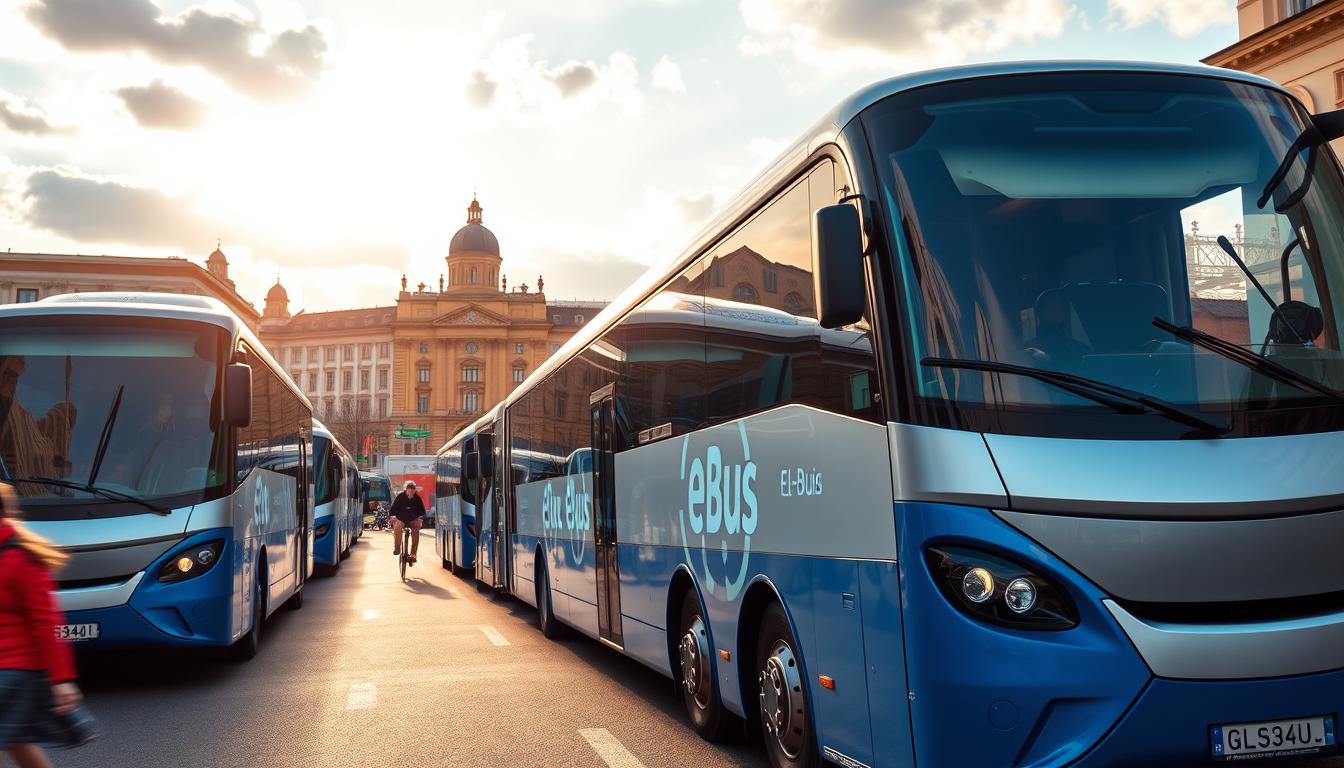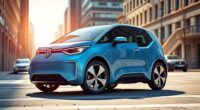By the end of 2024, nearly 2,950 battery-electric buses were in operation in Germany, according to the latest PwC E-Bus Radar. This represents a substantial increase in the adoption of sustainable transportation solutions in the country’s public transit system.
The growth of Germany’s electric bus fleet is attributed to various factors, including government initiatives and declining costs associated with sustainable transportation solutions.
Key Takeaways
- Nearly 2,950 battery-electric buses were in operation in Germany by the end of 2024.
- The growth is driven by government initiatives and declining costs.
- Germany’s public transit system is adopting more sustainable transportation solutions.
- The electric bus fleet is expected to continue growing.
- Sustainable transportation is becoming increasingly important in Germany.
The Current State of Germany’s Electric Bus Revolution
As Germany continues to embrace sustainable transportation, the electric bus sector is experiencing remarkable growth. This shift is driven by increasing demand for environmentally friendly public transportation solutions.
Key Statistics on Fleet Size and Distribution
The number of electric buses in Germany has seen a significant increase, with a sixfold rise since the end of 2020. Currently, there are 2,946 battery-electric buses and 339 fuel cell buses in operation. This growth indicates a strong commitment to reducing carbon emissions in the transportation sector.

Major Operators and Their Commitments
Major operators such as Mercedes-Benz, Solaris, and MAN are leading the charge in Germany’s electric bus revolution. These companies have made substantial commitments to expand their electric bus fleets, contributing to the overall growth of sustainable public transportation. Their efforts are pivotal in achieving Germany’s environmental goals.
Significantly More Electric Buses on Germany’s Roads: The Growth Trend
The growth trend of electric buses in Germany is gaining momentum, with a substantial increase in their numbers on the roads. This upward trajectory is a testament to the country’s commitment to sustainable transportation solutions.
Year-over-Year Expansion Data
Germany’s electric bus fleet has seen a remarkable year-over-year expansion. The data indicates a consistent increase in the adoption of electric buses, driven by both governmental support and the efforts of public transportation operators.
Recent statistics show that the number of electric buses has been steadily rising, with a significant portion of new registrations being electric. This trend is expected to continue, with plans to further expand the fleet.
Percentage Increase Compared to Diesel Fleets
Despite the growth in electric buses, diesel fleets still dominate Germany’s public transportation landscape. However, the percentage increase in electric buses compared to diesel fleets is noteworthy. Electric buses are gradually gaining ground, with their share of the total bus fleet increasing.
| Year | Electric Buses | Diesel Buses | Percentage of Electric Buses |
|---|---|---|---|
| 2020 | 1000 | 10000 | 9% |
| 2021 | 1500 | 9500 | 14% |
| 2022 | 2500 | 9000 | 22% |
Although plans to procure an additional 5,300 battery-electric buses and 880 fuel cell buses by 2030 have been postponed due to financing challenges, the overall trend remains positive. The growth in electric buses is expected to continue, driven by technological advancements and decreasing costs.
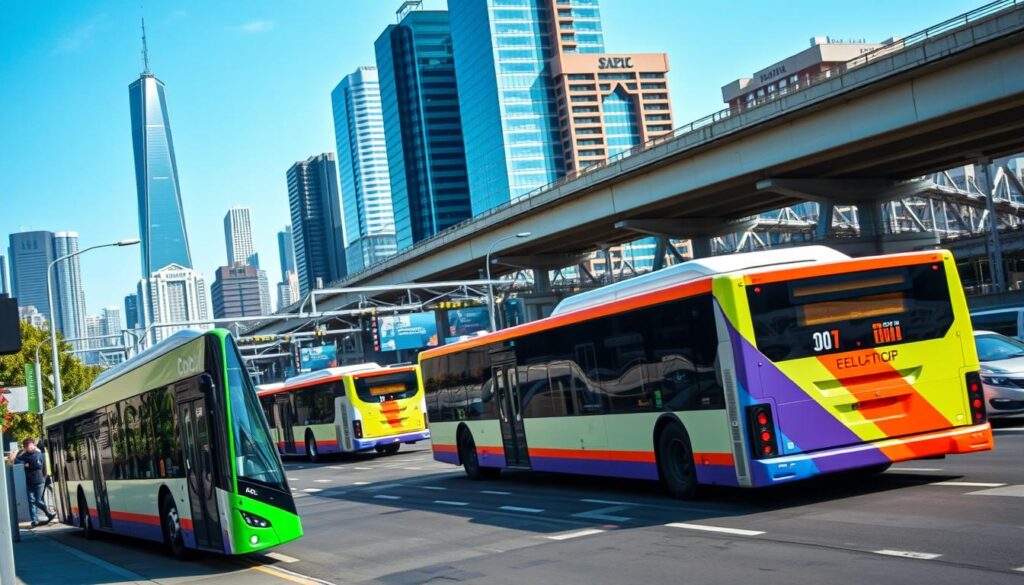
Leading German Cities Embracing Electric Public Transit
As Germany continues its transition to cleaner transportation, its leading cities are embracing electric public transit with ambitious programs. This shift is not only reducing carbon emissions but also setting a precedent for other urban areas to follow.
Berlin’s Ambitious Electrification Program
Berlin is at the forefront of this transition, planning to add nearly 1,150 e-buses to its fleet. This ambitious electrification program is part of Berlin’s broader strategy to enhance its public transportation system while minimizing environmental impact. The city’s commitment to electric buses is a significant step towards achieving a more sustainable urban mobility framework.
Hamburg’s Zero-Emission Transit Strategy
Hamburg is also making significant strides in electric public transit, aiming to put around 960 additional electric vehicles on the road by 2035. Hamburg’s zero-emission transit strategy involves not just the adoption of electric buses but also the development of necessary infrastructure to support them. This comprehensive approach underscores Hamburg’s dedication to reducing emissions and improving air quality.

Munich and Other Metropolitan Success Stories
Munich, along with other major German cities, is experiencing success with its electric bus initiatives. These cities are leveraging the benefits of electric public transit to create cleaner, healthier environments for their residents. The collective efforts of these metropolitan areas are driving the growth of electric bus adoption across Germany, demonstrating the feasibility and advantages of electric public transportation.
As these cities continue to expand their electric bus fleets, they are setting examples for other urban centers. The success stories from Berlin, Hamburg, and Munich highlight the potential for widespread adoption of electric buses, contributing to a more sustainable transportation future for Germany.
Popular Electric Bus Models Dominating the German Market
Germany’s transition to electric buses is being spearheaded by a few dominant models that have gained significant traction due to their technical specifications, range, and deployment success stories. The market is led by homegrown solutions as well as international models, contributing to the diversity of electric bus options available.
Mercedes-Benz eCitaro: Germany’s Homegrown Solution
The Mercedes-Benz eCitaro is a standout in the German electric bus market, with over 1,226 units leading the country’s electric bus fleet. Its success can be attributed to its robust technical specifications and range.
Technical Specifications and Range
The eCitaro boasts an impressive range of up to 320 kilometers on a single charge, making it suitable for various urban routes. Its advanced technology includes a sophisticated battery management system and efficient electric drivetrain.
Deployment Success Stories
Successful deployments in cities like Berlin and Hamburg have showcased the eCitaro’s reliability and performance. As one operator noted, “The eCitaro has been a game-changer for our fleet, offering a quiet and emission-free service to our passengers.”

MAN Lion’s City E: Performance and Adoption Rates
MAN’s Lion’s City E is another popular model, known for its performance and adoption rates. With 436 units in operation, it has established itself as a strong competitor in the German electric bus market.
The Lion’s City E has been praised for its agility and responsiveness, making it ideal for navigating Germany’s urban landscapes.
International Models Gaining Traction in Germany
While German manufacturers lead the market, international models are also gaining traction. Solaris, for instance, has seen significant success with 556 e-buses in operation. This diversity in the market is driving innovation and providing operators with a range of options.
As the market continues to evolve, it’s likely that we’ll see even more models entering the German electric bus market, further accelerating the country’s transition to sustainable public transport.
Environmental Impact of Germany’s Electric Bus Transition
As Germany continues to electrify its bus fleet, the environmental benefits are becoming increasingly evident. The shift towards electric buses is a significant step in reducing the country’s reliance on fossil fuels and mitigating the environmental impacts associated with traditional diesel buses.
Carbon Emission Reductions Achieved
The adoption of electric buses has led to a substantial reduction in carbon emissions across Germany. According to recent data, electric buses have reduced CO2 emissions by as much as 70% compared to their diesel counterparts. This significant reduction is a crucial step towards achieving Germany’s climate goals.
| Year | Number of Electric Buses | CO2 Reduction (tons) |
|---|---|---|
| 2020 | 500 | 10,000 |
| 2021 | 1,000 | 20,000 |
| 2022 | 1,500 | 30,000 |
Air Quality Improvements in Urban Centers
Besides reducing carbon emissions, the transition to electric buses has also significantly improved air quality in urban centers. Electric buses produce zero tailpipe emissions, reducing the levels of harmful pollutants such as nitrogen oxides and particulate matter. This improvement in air quality contributes to a healthier environment for urban residents.
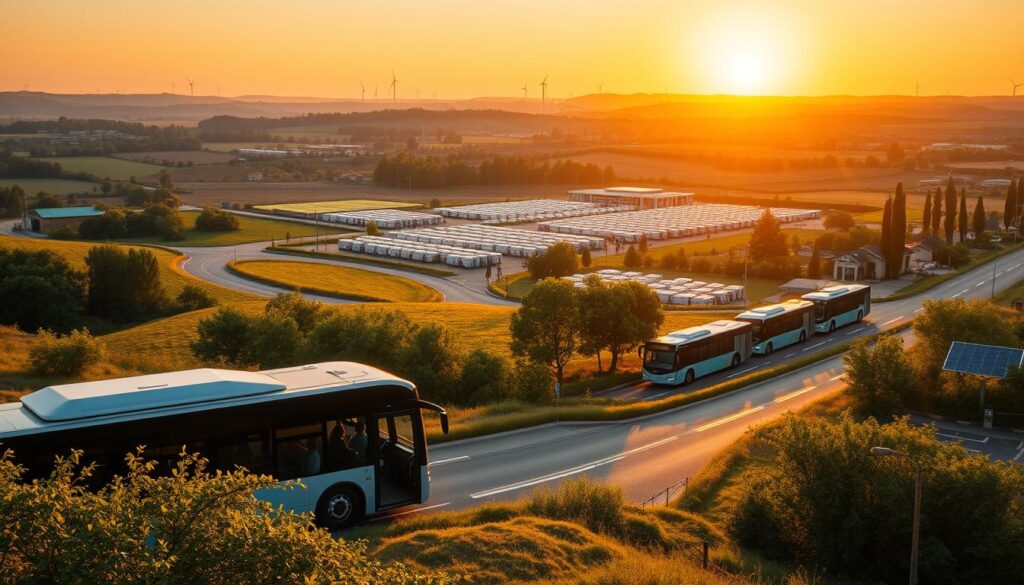
The continued adoption of electric buses in Germany is expected to further enhance both the reduction in carbon emissions and the improvement in air quality, aligning with the country’s broader sustainability and climate protection objectives.
Infrastructure Development Supporting the Electric Bus Boom
With the electric bus revolution gaining momentum in Germany, the development of supporting infrastructure is crucial. The expansion of electric buses necessitates a comprehensive network of charging stations and modernized depots to ensure efficient operation.
Charging Station Networks Across German Cities
The development of charging infrastructure is a critical component in supporting Germany’s growing electric bus fleet. Over 930 charging points are available along the TEN-T network, with plans for further expansion. Cities across Germany are investing heavily in charging station networks to accommodate the increasing number of electric buses.
Fast-Charging vs. Overnight Charging Solutions
German cities are adopting a mix of fast-charging and overnight charging solutions to meet the diverse needs of their electric bus fleets. Fast-charging technology allows buses to recharge quickly at strategic locations, while overnight charging provides a more gradual recharge at depots.
Integration with Renewable Energy Sources
To maximize the environmental benefits of electric buses, Germany is integrating its charging infrastructure with renewable energy sources. This approach ensures that the electricity used to power buses is generated sustainably, further reducing carbon emissions.
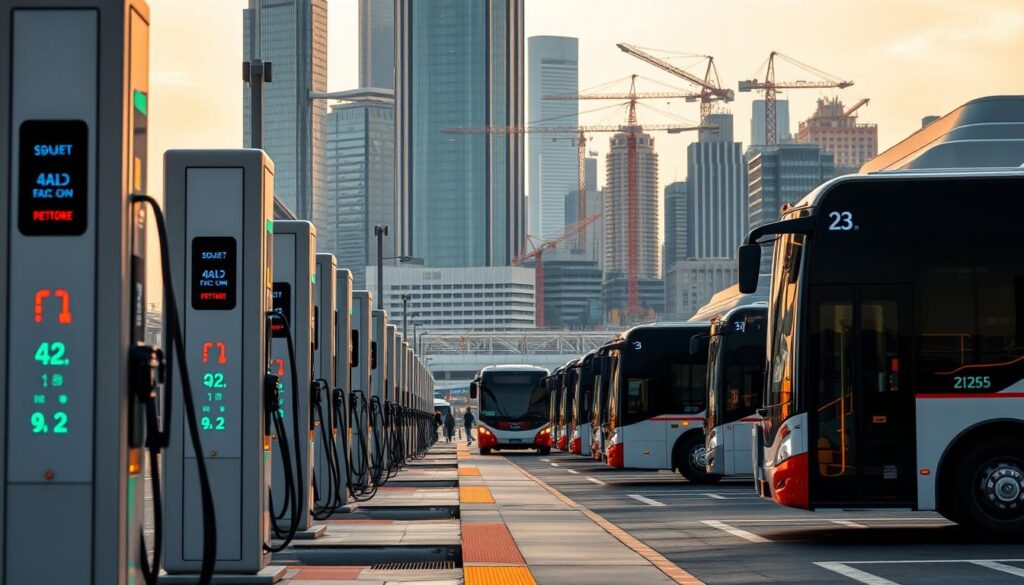
Depot Modernization Initiatives
In addition to charging infrastructure, depot modernization is a key aspect of supporting Germany’s electric bus fleet. Modern depots are being equipped with the necessary facilities to maintain and charge electric buses efficiently. These initiatives are crucial for ensuring the reliable operation of electric buses and supporting the continued growth of the fleet.
By investing in both charging infrastructure and depot modernization, Germany is creating a comprehensive support system for its electric bus fleet, paving the way for a more sustainable public transportation system.
Government Policies Driving Electric Bus Adoption
Electric bus adoption in Germany has been significantly driven by supportive government policies at both federal and regional levels. These policies have created a conducive environment for the growth of electric bus fleets across the country.
Federal Funding Programs and Incentives
The German government has introduced various federal funding programs to encourage the adoption of electric buses. For instance, the Federal Ministry for Digital and Transport (BMDV) had a funding program that supported the procurement of electric buses. Although the discontinuation of this program has presented challenges, its impact is still felt in the continued growth of electric bus fleets.
Key initiatives under federal funding have included subsidies for the purchase of electric buses and support for infrastructure development, such as charging stations. These incentives have been crucial in offsetting the higher initial costs associated with electric buses.
Regional and Municipal Support Mechanisms
Regional and municipal governments in Germany have also played a vital role in promoting electric bus adoption. Many cities have implemented their own support mechanisms, including funding for electric bus procurement and infrastructure development. For example, cities like Berlin and Hamburg have introduced zero-emission zones and provided financial incentives for operators transitioning to electric fleets.

These regional initiatives have not only complemented federal efforts but have also driven innovation in electric bus technology and deployment strategies. The combined effect of federal and regional support has been instrumental in Germany’s rapid transition to electric buses.
Challenges and Solutions in Germany’s Electric Bus Implementation
As Germany continues to expand its electric bus fleet, several challenges have emerged that need to be addressed to ensure the continued success of this transition. Despite the progress made, issues such as range anxiety, high initial costs, and technical challenges related to cold weather operation are significant hurdles.
Range Anxiety and Operational Adjustments
Range anxiety remains a concern for electric bus operators. To mitigate this, operators are implementing operational adjustments, such as optimizing routes and schedules to minimize energy consumption. Additionally, improving driver training on energy-efficient driving techniques is helping to alleviate range anxiety.
Initial Cost Barriers and Financial Solutions
The high upfront costs of electric buses are a significant barrier to adoption. However, various financial solutions are being explored, including government subsidies, leasing options, and innovative financing models that allow operators to pay for buses based on their actual usage.
Technical Challenges in Cold Weather Operation
Cold weather operation poses technical challenges for electric buses, including reduced battery efficiency. To address this, manufacturers are developing advanced battery technologies and thermal management systems to maintain performance in low temperatures.
| Challenge | Solution | Benefit |
|---|---|---|
| Range Anxiety | Operational adjustments, driver training | Increased efficiency, reduced anxiety |
| High Initial Costs | Government subsidies, leasing options | Reduced financial burden, increased adoption |
| Cold Weather Operation | Advanced battery technologies, thermal management | Improved performance, extended battery life |

Germany’s Position in the European Electric Bus Landscape
The European electric bus landscape is evolving, with Germany playing a crucial role. As the continent shifts towards more sustainable public transportation, Germany’s efforts are being closely watched by other nations.
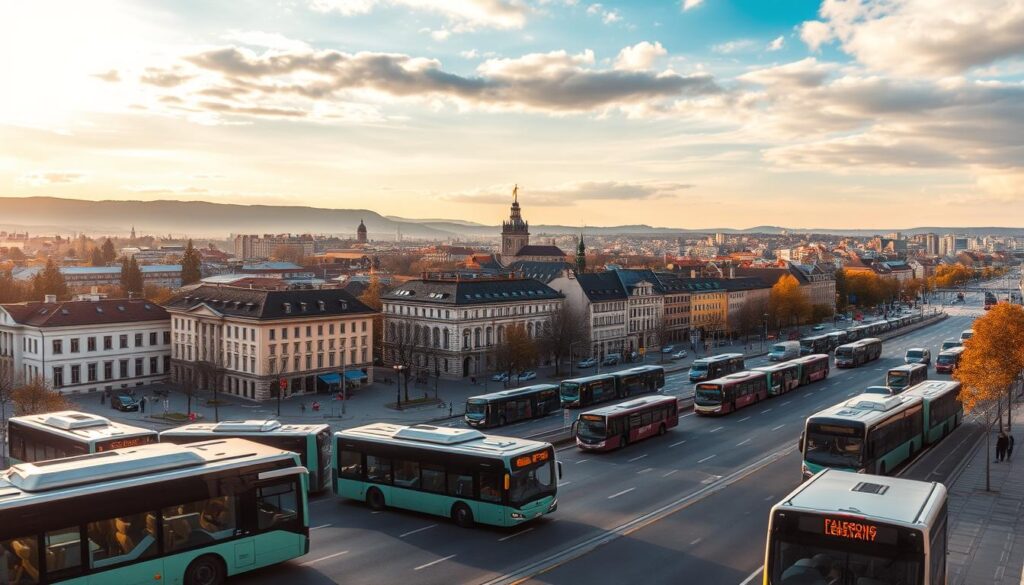
Comparison with Other Leading European Nations
Germany is among the leading European countries in electric bus adoption. According to recent data, Germany’s electric bus fleet is comparable in size to that of other major adopters like the UK and France. Berlin, for instance, has committed to electrifying its entire public bus fleet by 2030, a goal that aligns with the ambitions of other European capitals.
The adoption rates vary across Europe, with some countries like Norway leading in per-capita electric bus adoption. However, Germany’s large population and economic influence make its progress significant for the overall European landscape.
Collaborative Cross-Border Initiatives
Germany is also engaging in collaborative cross-border initiatives to accelerate the adoption of electric buses across Europe. Projects funded by the European Union are facilitating the exchange of best practices, technologies, and policies among member states.
“The European Union’s support for cross-border initiatives is crucial for creating a unified and efficient electric bus network across Europe.” – European Commission
One such initiative is the development of standardized charging infrastructure, which will simplify the deployment of electric buses across different countries. Germany’s participation in these initiatives not only enhances its own electric bus ecosystem but also contributes to the broader European goal of reducing emissions.
Conclusion: The Future Trajectory of Germany’s Electric Bus Fleet
Germany’s electric bus fleet is poised for continued growth, driven by ongoing plans to procure additional electric buses. Despite challenges and delays, the commitment to sustainable transportation remains strong.
The future trajectory of Germany’s electric bus fleet will be shaped by efforts to address existing challenges, including range anxiety, initial cost barriers, and technical issues in cold weather operation. As major operators like Mercedes-Benz and MAN continue to innovate and improve their electric bus offerings, the industry is likely to see significant advancements.
With federal funding programs and regional support mechanisms in place, Germany is well-positioned to achieve its goals for electric bus adoption. As the country’s electric bus fleet continues to expand, it is likely to play a key role in shaping the future of sustainable transportation in Europe.
